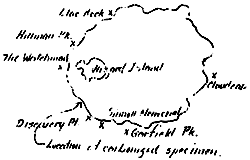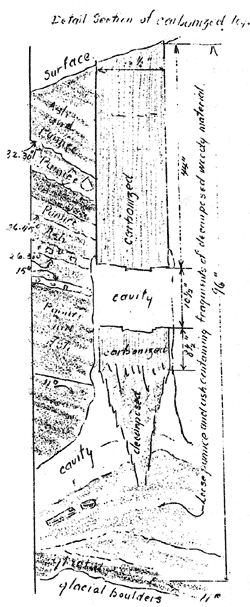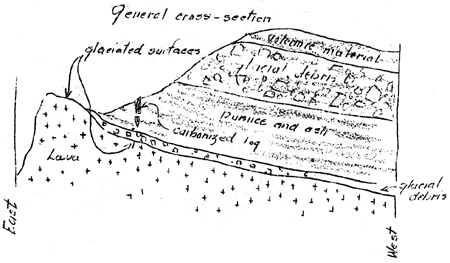|
Volume VI No. 3 - August, 1933
Carbonized Tree Found Within The Rim
By Park Naturalist D. S. Libbey
One of the most significant discoveries that has been made since
Crater Lake has been known to white men was made on August 1. A
carbonized tree trunk in upright position was discovered within the rim
of Crater Lake by Ranger - Naturalist Albert E. Long while he was
assigned to research study. On August 7 Mr. Long in company with the
writer uncovered the specimen. A complete photographic record of the
find was taken, pictures being taken prior to any excavation, and at the
significant stages in the progress of unearthing the specimen. The
sketch below indicates the location of the find within the rim of the
crater.

Only a very small portion of the specimen was exposed. The log as
unearthed was 13-1/2 inches in diameter at the top and 15-1/2 at the
base and stood in an almost upright position, leaning six degrees to the
north. The excavation of the find was only partially completed so that
only one side of the log was exposed, revealing the positive evidence of
the in situ character of the find.
By reference to the accompanying diagram it will be seen that the
total length of the log was 52 inches. It is evident that the stump and
bole of the tree was the portion found. The lower section, including the
huge branching roots, was not carbonized, and large cavities resulted
from the disintegration and decomposition of the roots and stump. The
entire section was as follows: 44 inches from the top completely
carbonized, then a break occurred with a cavity 10-1/2 inches resulting
from the slipping of the lower section. The lower portion of the stump
and roots decomposed and the cavity resulted.
Below the break 8-1/2 inches of carbonized log was found which
graded into the uncarbonized material which progressively became more
decomposed until finally the huge open space was found, which resulted
from the decomposition of the uncarbonized stump and roots.

The roots now decomposed were originally imbedded in a layer of
glacial debris, (mixed rocks, and ash and glacial clays resulting from
the breaking down of andesite rocks). This bedded material was dipping
at an angle of 11 degrees to the west. The layers on top rest in various
attitudes. The layers in sequence from the base up were found to repose
at attitudes of 11 degrees, 15 degrees, 26 degrees 15 minutes, 26
degrees 45 minutes, and 30 degrees 30 minutes.
The roots and stump rested on a mass of heterogeneous glacial
debris. The bole of the tree just above the glacial imbedded stump and
roots was surrounded with pumice and pumicite material which evidently
fell and tumbled down the slope after it was cool and hence the lower
portion was not carbonized.
The carbonized portion was imbedded in angular pumice fragments
interspersed with pumice dust and ash material. The inner facing crest
of the rim above the location of this discovery consists of an
overburden of slightly sorted glacial debris, intermingled with
pumicite.
In 1931 the writer published in Crater Lake Nature Notes (Vol. IV,
No. 1) an article titled "Carbonized Wood - An Index to the Past", which
reported the discovery of huge carbonized logs in the excavation along
the new Diamond Lake Highway, still under construction. A cross-section
of a huge log was obtained by the writer during July, 1931 and was
placed in the museum room of the Sinnott Memorial where it now rests. On
July 27 of this year in company with Mr. John R. Sargent, Resident
Engineer for the Bureau of Public Roads, the writer obtained another
cross-section of a carbonized log from the Diamond Lake Highway
excavation approximately ten miles above the place where the 1931
specimen was taken. It is planned to place this specimen in the museum
room of the Watchman Observation Station with a marker pointing to the
place from which the find was taken. The specimen was found just to the
east of the Rabbit Ears, 20 miles to the west of the rim of Crater Lake,
25 feet above and 100 yards from the stream course of the Rogue River.
These finds are mentioned since their discovery in situ with
an overburden of volcanic pumice, dust and ash resting over the logs to
a depth of 60 feet, points to the fact that the logs were covered by the
explosive volcanic material so thickly and so fast that air was excluded
and the hot material caused carbonization without combustion. The recent
find of August 1 by Ranger-Naturalist Long establishes the fact that a
similar action occurred on the outer slope of the old volcanic cone.

Conclusions
The location of a carbonized log within the existing crater slope,
with a stump and roots uncarbonized and partially decomposed, presents
many problems of great importance. It is quite evident that the
attrition or wearing of the inner rim slope has shifted the crest of the
rim outward and that at the time of entombment the tree was growing on
the radiating slope of old Mt. Mazama. The tree was growing on a
glaciated surface covered with glacial debris. Cool pumice and pumicite
tumbled down the slope above to cover the roots and base of the tree,
and then at a subsequent time hot volcanic ejecta, pumice, and ash
settled around the tree so fast that air was excluded, combustion was
prevented, and carbonization resulted. Subsequent glaciation ground down
the sloping surface of the pumice, ash, and dust which had covered and
carbonized the tree. The erosion at the rim slope has shifted outward so
that now the specimen is located within the existing crest of the crater
rim.
The wood of the roots and base of the tree trunk at the present time
being only partially decomposed presents an implication that the
explosive activity of Mt. Mazama was more recent than previously
estimated. The presence of the upper glacial deposit establishes the
fact that the entombment of this specimen was made prior to the
destruction of the old volcanic cone since the higher elevations of the
mountain necessarily existed in order to have a glacier form. The
resulting distribution of glacial debris is one of the topmost coverings
of the rim crest post-dates the final volcanic activity.
The similar conditions on entombment, carbonization of logs, and
excessive depth of volcanic debris in the Diamond Lake Highway
excavation postulates the tremendous amount of eruptive material
distributed by explosive action of the volcano. It appears reasonable to
assume that explosive action was the major force involved in the
destruction of the upper portion of the volcanic cone, although it is
possible subsidence, sapping, and undermining may have contributed an
appreciable pat of the enlargement of the original crater.
| 
